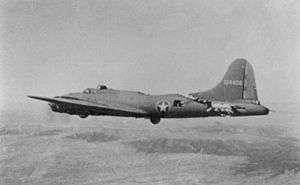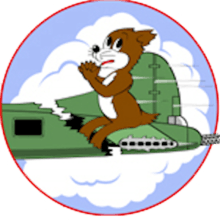All American (aircraft)
| All American | |
|---|---|
 | |
| The All American returning to base after its collision with an enemy fighter | |
| Type | Boeing B-17F-5-BO Flying Fortress[1] |
| Manufacturer | Boeing |
| Manufactured | þ |
| Serial | 41-24406[1] |
| Fate | Dismantled for salvage at Lucera Airfield, Italy, on March 6, 1945.[2] |
The All American (proper name All American III[1]) was a World War II Boeing B-17F Flying Fortress bomber aircraft that was able to return safely to its base after having its rear fuselage nearly cut off by an in-flight collision with a German fighter over enemy-held territory. The bomber's flight is said to have yielded one of the most famous photographs of World War II, and has been linked with the phrase "Comin' in on a Wing and a Prayer." It inspired the 414th Bombardment Squadron's emblem, an image of a puppy praying atop an aircraft's tail section.
The aircraft
The All American was a B-17F-5-BO, serial number 41-24406, in the 97th Bomb Group, 414th Bombardment Squadron.[1]
The mission
On February 1, 1943, bombers of the 414th Bombardment Squadron departed their base near Biskra, Algeria, to attack the German-controlled seaports, Bizerte and Tunis, Tunisia.[3] After dropping their bombloads and returning toward base, the bombers were attacked by German fighters,[3] believed to be Messerschmitt Bf 109s.[4] Two fighters attacked respective bombers, the lead B-17 and the All American which was flying next to it in formation.[3] The bombers' machine gun fire downed the first fighter, but the second pressed its head-on attack against the All American.[3] Apparently struck by machine gun rounds, the second fighter could not complete its roll to pull down and away from the All American, the fighter pilot apparently having been killed or disabled.[3][5] The German pilot was reported as being 16-victory ace Erich Paczia of I/Jagdgeschwader 53.[6]


Out of control, the second fighter's wing collided with the top rear fuselage of the All American, almost cleaving the bomber's tail section off, leaving a large diagonal gash from the base of the All American's tail and severing the left horizontal stabilizer completely off the plane.[3] Metal in the airframe near the right tailplane was the only thing keeping the tail section, housing the rear gunner, attached to the aircraft.[3][7] The fighter broke apart but left some pieces in the bomber's fuselage.[7]
The bomber squadron maintained formation to protect the All American until they were beyond range of enemy fighters, with the crew donning parachutes in expectation of having to bail out.[3][4][5] However, the aircraft was piloted to a safe landing at its base, and despite damage to the aircraft none of the crew was injured on that mission.[3]
The All American was repaired and returned to service as a hack[4] with the 352nd Bombardment Squadron (Heavy), 301st Bombardment Group (Heavy), and flew until its March 1945 dismantlement.[2]
The All American is reputed to be the source of the phrase, "Comin' in on a Wing and a Prayer,"[3][4][5] and inspired the 414th Bombardment Squadron's emblem.[3] An image of a puppy praying atop the rear fuselage formed the unit badge.[4][5] The aircraft was the subject of what was called one of the most famous photographs of World War II.[5][7]
Mythology
Several false myths accrued in the lore of the All American,[8] some of which were refuted in a 2012 interview of her bombardier Ralph Burbridge.[5] Burbridge explained that the aircraft returned to her base in North Africa, and could not have made a long trip back to England as widely recounted.[5] The base near Biskra, Algeria, was a more reasonable 300 miles from the bombing target.[8]
Burbridge also said that the collision occurred when the bomber group was returning to base after having dropped its bombs on target, so that the aircraft did not complete a bombing run after being damaged as had been incorrectly recounted.[5] Burbridge's account confirms that the ten crew members donned their parachutes, contradicting stories that the crew sacrificed some of their parachutes to hold the plane together or for an in-flight rescue of crew members from the isolated tail section.[5]
The Harold Adamson and Jimmy McHugh 1943 song “Comin' in on a Wing and a Prayer” was not written about All American as sometimes reported, but was about another 97th Bomb Group B-17, Thunderbird.[8]
Crew members
Navigator Harry C. Nuessle listed the All American's crew on its February 1, 1943 flight:[4][7]
- Pilot - Ken Bragg Jr.
- Copilot - G. Boyd Jr.
- Navigator - Harry C. Nuessle
- Bombardier - Ralph Burbridge
- Engineer - Joe C. James
- Radio Operator - Paul A. Galloway
- Ball Turret Gunner - Elton Conda
- Waist Gunner - Michael Zuk
- Tail Gunner - Sam T. Sarpolus
- Ground Crew Chief - Hank Hyland
References
- 1 2 3 4 "Boeing B-17F". National Museum of the U.S. Air Force. Archived from the original on August 8, 2016. Retrieved August 8, 2016.
- 1 2 "1 February 1943". This Day in Aviation. Archived from the original on February 3, 2015.
- 1 2 3 4 5 6 7 8 9 10 11 Axberg, Jason, 628th Air Base Wing historian (February 3, 2015). "A new perspective on a challenging day at work". U.S. Air Force, Joint Base Charleston. Archived from the original on August 7, 2016.
- 1 2 3 4 5 6 "A Wing and a Prayer". The Aviation History Online Museum. August 28, 2013. Archived from the original on July 5, 2016.
- 1 2 3 4 5 6 7 8 9 Interview with bombardier Ralph Burbridge published by Nichols, Ralph (September 21, 2012). "Local B-17 Bombardier Recalls 'Wing and a Prayer' Mission on the All American". The Waterland Blog. Archived from the original on June 17, 2016.
- ↑ Aviation History Museum (2013-08-28) cites Hess, William N. (1997). Wings of Fame, Boeing B-17 Flying Fortress. London: Aerospace Publishing Ltd. p. 63.
- 1 2 3 4 "A Flying Fortress Miracle". Experimental Aircraft Association (EAA). 2015. Archived from the original on January 8, 2015.
- 1 2 3 "WWII's B-17 All American: Separating Fact and Fiction". Warbirds News. June 27, 2013. Archived from the original on April 5, 2016.